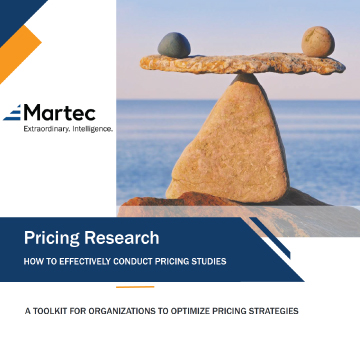This is Part Three of a three-part series on pricing strategies to help companies navigate the uncertain future that inflation and ongoing supply chain issues are creating. For Part One on Price-Value Mapping, click here and for Part Two on Benefit-Value Analysis, click here. To read all three installments in full detail, complete with graphics, illustrations, and applicable case studies, download the full eBook here.
Companies in virtually any sector of the economy compete on price. This is not always a race to the bottom or to always be the “low bidder.” In fact, sometimes pricing strategies involve raising prices in order to move up the perceived value hierarchy, enter new markets, or increase profit margins where opportunities exist.
Yet during times of persistent inflation, pricing tends to attract even greater scrutiny, as shopping behaviors evolve, wallets tighten, and overall market size retracts. When inflation meets recession, that scrutiny becomes all the more prevalent.
A danger arises if scrutiny is only applied inward. Too often companies only consider their own pricing strategies when it might be wiser to consider them within the full context of competitive pricing. Making decisions without analyzing a comprehensive set of data can lead to missteps and missed opportunities—opportunities to increase market share, penetrate new and adjacent markets, assume premium position in the market, or increase profit margins by examining the entire value chain against competitive pricing.
What is Competitive Price Benchmarking?
Competitive Price Benchmarking is a specific Competitive Intelligence methodology that is designed to reduce strategic risk through the ethical collection of benchmark data and information.
The need for Competitive Price Benchmarking can be driven by a number of proactive and reactive strategies. In some cases, a manufacturer or service provider may embark on a Competitive Price Benchmarking study due to a competitor’s pricing move, either up or down. In other instances, a company may more proactively engage in Competitive Price Benchmarking to better understand their own pricing strategies relative to competitors in the same marketplace, to benchmark pricing against new and unfamiliar competitors in ancillary markets, or to assess the overall pricing landscape when entering new markets.
Specific applications of these studies may be to learn:
- How to stay price-competitive in a saturated or commodity market
- How to drive market share growth with new, innovative products
- How to allocate resources toward promoting the most profitable product lines and stock keeping units (SKUs)
- How to defend a market position against existing, new, or emerging competitive threats or dynamics
- How to successfully grow into new, adjacent, or ancillary markets, based on pricing positions of competitors with potentially acquirable market share
Companies often consider Competitive Price Benchmarking to gain market share or increase profitability. Specifically, a margin analysis of competitive products and product lines may reveal opportunities to “double down” on product sets or SKUs that yield more profit margin versus competitors’ products. Given that final product pricing at retail is impacted (marked up) at many points in the value chain – from supply to distribution to vendor partners and retail – companies can gain a competitive advantage by investing resources in product lines with greater margins, in part to account for fluctuations in pricing along the entire value chain.
Keys to Successful Competitive Pricing Analyses
In many industries, price can be a significant, if not the most important, criterion customers use when evaluating a purchasing decision. In particularly crowded marketplaces, this is especially true. However, that doesn’t necessarily mean that companies should reflexively attempt to win “a race to the bottom,” as that often results in a decrease in profit margin and can diminish the value perception of the overall brand, product, or service. A company’s competitive response to pricing requires key business intelligence, as well as a strategic application of what that intelligence yields.
In “the old days,” when product pricing was published in print and easily accessible to anyone wishing to purchase a green book or blue book, the need for extensive research into competitors’ pricing positions may not have been as prevalent. But no longer. Today, product pricing is online, often stored behind firewalls, and very cumbersome to access. If you don’t have a reliable way to gain access, you might have to resort to unreliable “web scraping,” which can return imprecise and out-of-date information. To attain an accurate and comprehensive pricing picture, companies rely on extensive and confidential Competitive Price Benchmarking studies.
The most successful studies are typically marked by:
- Deep relationships with industry experts. Look for a research partner that has invested considerable time and resources developing and strengthening long-term relationships with industry subject matter experts. These on-the-ground experts bring direct knowledge of a given target market, its players, the domain’s pricing history, and insights into future trends.
- Confidential, in-depth interviews. In-depth interviews should be conducted in a dynamic, iterative approach, with built-in flexibility that allows the research team to fully engage respondents and explore as much information as possible, as well as to flush out unforeseen topics which may be raised and incorporated into the ongoing process. In contrast to simple surveys, interviewers can ask questions that a client company cannot directly ask themselves, yielding richer insights and more authentic responses. Be sure the research team has institutional knowledge into which methodologies are legal, ethical, and proper, which can vary greatly from market to market, industry to industry, and region to region.
- Triangulation, vetting, and validation. True Competitive Price Benchmarking research is much more than looking up and reporting on data that’s open and obvious. What’s often required is in-depth analysis to vet, validate, and confidently report actual data that’s market-tested and “live” in the real world. It’s more than simply relying on spreadsheets that may be out-of-date or mere projections and not consistent with the actual pricing that the given market and entire value chain is bearing at any specific point in time. A critical step is to triangulate any data the research yields, using multiple sources and methodologies, so a client company can consider the resulting analysis with confidence.
- The big picture, the granular data, and the complete view of the market. In addition to delivering against stated objectives, you should ask a research partner to provide any further, additive qualitative input identified in the course of pursuing stated objectives that may inform business, strategy, or plans. Simply put, be open to not only the answers you send the research team to go looking for, but also to new discoveries, unknown information, and any other relevant data that can be used as a part of your pricing decision-making process.
Competitive intelligence in price benchmarking from this process can embolden strategy planning, create greater certainty around pricing strategies, and present previously unconsidered pricing strategies, as unknowns soon become knowns.
The key to successfully implementing Competitive Price Benchmarking studies is to:
- Gather information quickly
- Filter out “noise”
- Organize competitive data efficiently
- Extract meaningful insights in a timely manner
How to Apply Insights Gained from Competitive Price Benchmarking Studies
Companies that engage in Competitive Price Benchmarking studies report one of two primary benefits: either the confidence gained through the validation of existing pricing strategy or new and innovative strategic initiatives that are uncovered through the study of what were previously “hidden” data points and intelligence.
As the beneficiary of the price benchmarking intelligence, you can more clearly and confidently:
- Assess, compare, and adjust key pricing metrics across the value chain
- Outline your various competitors’ pricing positions, including unknown or little-understood competitive forces, such as those in new or ancillary markets
- Study granular data, even down to the SKU level, for large product sets with multiple competitors
- Drive bottom-line results by achieving a deeper understanding of your competitive position in the market, such as opportunities to increase margin, enter new markets, or price based on value proposition, rather than in merely cost-competitive ways
- Increase revenue opportunities by allowing third-party analysts to get the difficult questions answered that you cannot ask or find about your competitive space
When you understand how top competitors in your market are pricing their products or services and how that pricing might impact customers’ expectations, you have a foundation for optimizing your own pricing strategy, with purpose, precision, and confidence.
Download the eBook, “Pricing Research: How to Effectively Conduct Pricing Studies,” now to see an in-depth explanation of the methodologies applied during Competitive Price Benchmarking studies, many of which are proprietary and unique to The Martec Group.
To read all three installments in full detail, complete with graphics, illustrations, and applicable case studies, download the full report today.





